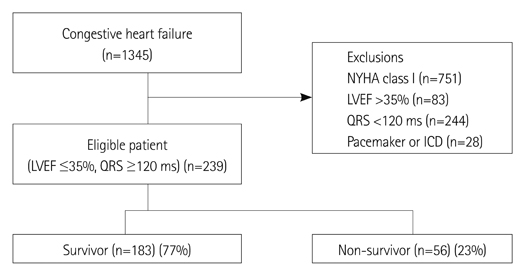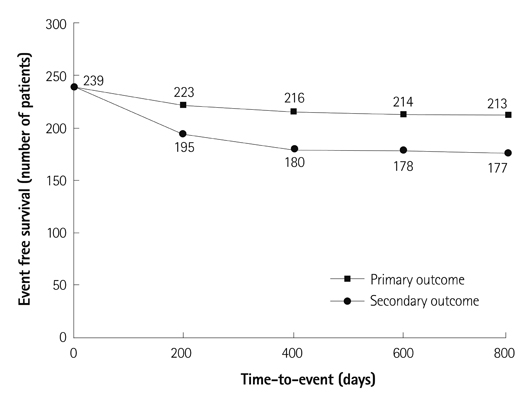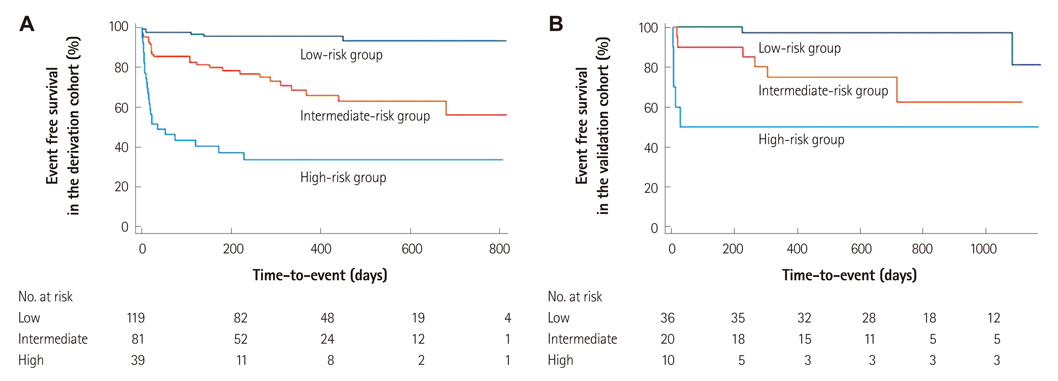Korean Circ J.
2012 Oct;42(10):659-667. 10.4070/kcj.2012.42.10.659.
Prognostic Estimation of Advanced Heart Failure With Low Left Ventricular Ejection Fraction and Wide QRS Interval
- Affiliations
-
- 1Department of Internal Medicine, Yonsei University College of Medicine, Seoul, Korea. hjchang@yuhs.ac
- 2Research Affairs, Yonsei University College of Medicine, Seoul, Korea.
- KMID: 1826462
- DOI: http://doi.org/10.4070/kcj.2012.42.10.659
Abstract
- BACKGROUND AND OBJECTIVES
Cardiac resynchronization therapy (CRT) has been known to improve the outcome of advanced heart failure (HF) but is still underutilized in clinical practice. We investigated the prognosis of patients with advanced HF who were suitable for CRT but were treated with conventional strategies. We also developed a risk model to predict mortality to improve the facilitation of CRT.
SUBJECTS AND METHODS
Patients with symptomatic HF with left ventricular ejection fraction < or =35% and QRS interval >120 ms were consecutively enrolled at cardiovascular hospital. After excluding those patients who had received device therapy, 239 patients (160 males, mean 67+/-11 years) were eventually recruited.
RESULTS
During a follow-up of 308+/-236 days, 56 (23%) patients died. Prior stroke, heart rate >90 bpm, serum Na < or =135 mEq/L, and serum creatinine > or =1.5 mg/dL were identified as independent factors using Cox proportional hazards regression. Based on the risk model, points were assigned to each of the risk factors proportional to the regression coefficient, and patients were stratified into three risk groups: low- (0), intermediate-(1-5), and high-risk (>5 points). The 2-year mortality rates of each risk group were 5, 31, and 64 percent, respectively. The C statistic of the risk model was 0.78, and the model was validated in a cohort from a different institution where the C statistic was 0.80.
CONCLUSION
The mortality of patients with advanced HF who were managed conventionally was effectively stratified using a risk model. It may be useful for clinicians to be more proactive about adopting CRT to improve patient prognosis.
MeSH Terms
Figure
Reference
-
1. Mosterd A, Cost B, Hoes AW, et al. The prognosis of heart failure in the general population: the Rotterdam Study. Eur Heart J. 2001. 22:1318–1327.2. Jessup M, Abraham WT, Casey DE, et al. 2009 focused update: ACCF/AHA guidelines for the diagnosis and management of heart failure in adults: a report of the American College of Cardiology Foundation/American Heart Association Task Force on Practice Guidelines: developed in collaboration with the International Society for Heart and Lung Transplantation. Circulation. 2009. 119:1977–2016.3. Bardy GH, Lee KL, Mark DB, et al. Amiodarone or an implantable cardioverter-defibrillator for congestive heart failure. N Engl J Med. 2005. 352:225–237.4. Epstein AE, DiMarco JP, Ellenbogen KA, et al. ACC/AHA/HRS 2008 guidelines for device-based therapy of Cardiac Rhythm Abnormalities: a report of the American College of Cardiology/American Heart Association Task Force on Practice Guidelines (Writing Committee to Revise the ACC/AHA/NASPE 2002 Guideline Update for Implantation of Cardiac Pacemakers and Antiarrhythmia Devices) developed in collaboration with the American Association for Thoracic Surgery and Society of Thoracic Surgeons. J Am Coll Cardiol. 2008. 51:e1–e62.5. Cleland JG, Daubert JC, Erdmann E, et al. The CARE-HF Study (CArdiac REsynchronisation in Heart Failure Study): rationale, design and end-points. Eur J Heart Fail. 2001. 3:481–489.6. Feldman AM, de Lissovoy G, Bristow MR, et al. Cost effectiveness of cardiac resynchronization therapy in the Comparison of Medical Therapy, Pacing, and Defibrillation in Heart Failure (COMPANION) Trial. J Am Coll Cardiol. 2005. 46:2311–2321.7. Bristow MR, Saxon LA, Boehmer J, et al. Cardiac-resynchronization therapy with or without an implantable defibrillator in advanced chronic heart failure. N Engl J Med. 2004. 350:2140–2150.8. Lee DS, Austin PC, Rouleau JL, Liu PP, Naimark D, Tu JV. Predicting mortality among patients hospitalized for heart failure: derivation and validation of a clinical model. JAMA. 2003. 290:2581–2587.9. Fonarow GC, Yancy CW, Albert NM, et al. Heart failure care in the outpatient cardiology practice setting: findings from IMPROVE HF. Circ Heart Fail. 2008. 1:98–106.10. Rassi A Jr, Rassi A, Little WC, et al. Development and validation of a risk score for predicting death in Chagas' heart disease. N Engl J Med. 2006. 355:799–808.11. Upadhyay GA, Choudhry NK, Auricchio A, Ruskin J, Singh JP. Cardiac resynchronization in patients with atrial fibrillation: a meta-analysis of prospective cohort studies. J Am Coll Cardiol. 2008. 52:1239–1246.12. Jarcho JA. Biventricular pacing. N Engl J Med. 2006. 355:288.13. Curtis AB, Yancy CW, Albert NM, et al. Cardiac resynchronization therapy utilization for heart failure: findings from IMPROVE HF. Am Heart J. 2009. 158:956–964.14. Van Veldhuisen DJ, Maass AH, Priori SG, et al. Implementation of device therapy (cardiac resynchronization therapy and implantable cardioverter defibrillator) for patients with heart failure in Europe: changes from 2004 to 2008. Eur J Heart Fail. 2009. 11:1143–1151.15. Hays AG, Sacco RL, Rundek T, et al. Left ventricular systolic dysfunction and the risk of ischemic stroke in a multiethnic population. Stroke. 2006. 37:1715–1719.16. Adams RJ, Chimowitz MI, Alpert JS, et al. Coronary risk evaluation in patients with transient ischemic attack and ischemic stroke: a scientific statement for healthcare professionals from the Stroke Council and the Council on Clinical Cardiology of the American Heart Association/American Stroke Association. Circulation. 2003. 108:1278–1290.17. Touzé E, Varenne O, Chatellier G, Peyrard S, Rothwell PM, Mas JL. Risk of myocardial infarction and vascular death after transient ischemic attack and ischemic stroke: a systematic review and meta-analysis. Stroke. 2005. 36:2748–2755.18. Patel JJ, Whittaker CT. Tachycardia-induced heart failure. Perm J. 2007. 11:50–52.19. Oren RM. Hyponatremia in congestive heart failure. Am J Cardiol. 2005. 95(9A):2B–7B.20. McAlister FA, Ezekowitz J, Tonelli M, Armstrong PW. Renal insufficiency and heart failure: prognostic and therapeutic implications from a prospective cohort study. Circulation. 2004. 109:1004–1009.21. Sarnak MJ, Levey AS, Schoolwerth AC, et al. Kidney disease as a risk factor for development of cardiovascular disease: a statement from the American Heart Association Councils on Kidney in Cardiovascular Disease, High Blood Pressure Research, Clinical Cardiology, and Epidemiology and Prevention. Circulation. 2003. 108:2154–2169.22. Iuliano S, Fisher SG, Karasik PE, Fletcher RD, Singh SN. Department of Veterans Affairs Survival Trial of Antiarrhythmic Therapy in Congestive Heart Failure. QRS duration and mortality in patients with congestive heart failure. Am Heart J. 2002. 143:1085–1091.23. Thohan V. Prognostic implications of echocardiography in advanced heart failure. Curr Opin Cardiol. 2004. 19:238–249.24. Levy WC, Mozaffarian D, Linker DT, et al. The Seattle Heart Failure Model: prediction of survival in heart failure. Circulation. 2006. 113:1424–1433.25. O'Connor CM, Hasselblad V, Mehta RH, et al. Triage after hospitalization with advanced heart failure: the ESCAPE (Evaluation Study of Congestive Heart Failure and Pulmonary Artery Catheterization Effectiveness) risk model and discharge score. J Am Coll Cardiol. 2010. 55:872–878.
- Full Text Links
- Actions
-
Cited
- CITED
-
- Close
- Share
- Similar articles
-
- Prognostic Implications of Changes in Left Ventricular Ejection Fraction and Pulmonary Hypertension in Patients with Heart Failure with Reduced Ejection Fraction
- Changes in QRS Duration Are Associated with a Therapeutic Response to Sacubitril–valsartan in Heart Failure with Reduced Ejection Fraction
- Evaluation of Diastolic Dysfunction and the Role Thereof in Heart Failure with Preserved Ejection Fraction
- Evaluation of Ejection Fraction Obtained by Echocardiography and Radionuclide Ventriculography
- Total intravenous anesthesia using remimazolam for patients with heart failure with reduced ejection fraction: a case series




